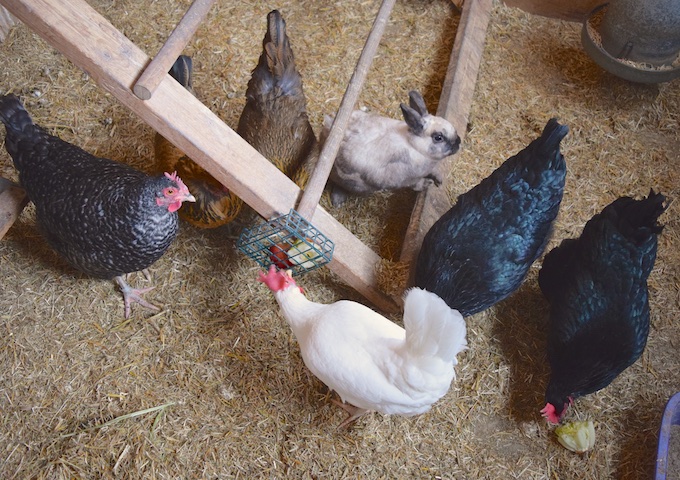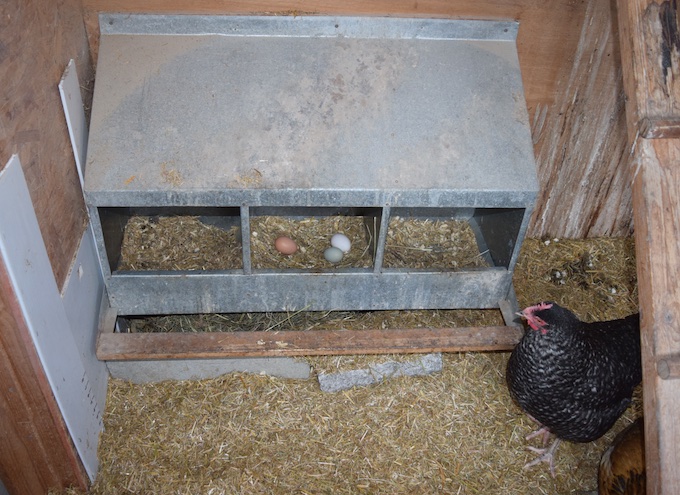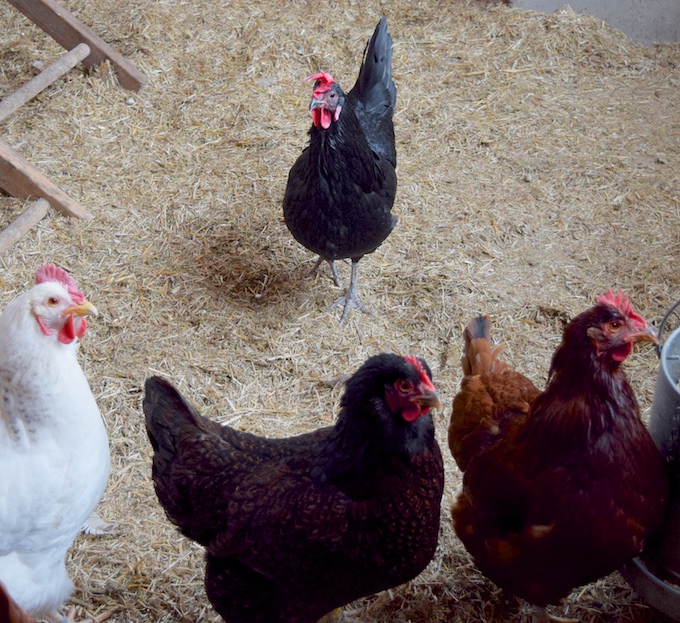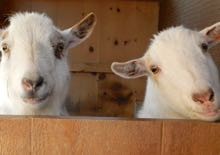If you keep pullets that hatched last springtime, then you’ve likely been enjoying their eggs all winter. Laying might have slowed down, but it shouldn’t have ceased. (You don’t even need a lightbulb in the coop for winter eggs from young chickens.) If you have older hens, that molted this past autumn, then February is the month when they get back into lay because the molt has given them a rejuvenating break and sunlight is increasing. For some of my hens, February and March are peak laying months. But, for many hen keepers this is a time of worry. Why isn’t my hen laying? What’s wrong?
Let’s look at my chickens for an explanation of why some hens lay and others don’t. I have two flocks. They live in separate barns, but each structure has large east and south-facing windows. The chickens are fed the same feed – I use Poulin Grain laying hen pellets – supplemented with oyster shell and grit, free choice, vegetable scraps from my kitchen, and a small amount of scratch grains. I toss chopped alfalfa into the bedding. Both flocks are healthy and have been exposed to the same germs and worms. Both flocks are a mix of breeds. All molted at the end of last summer.
All six hens in the Little Barn are laying. (There’s one girl in this photo who is not making eggs, but she’s not a chicken!)
The hens don’t lay daily, but still, I’m collecting about three eggs a day.
Astoundingly, the White Leghorn, Twiggy, never did a full molt! I know this, because there were no white feathers strewn about the coop. Although in December her laying slowed to only two eggs a week, she never stopped. No wonder the modern hybrids used in industrial farms are descendants of the Leghorn.
Meanwhile, only one hen of the ten in the Big Barn is laying. Misty. The Andalusian.
What’s going on? The answer is simple. The nine hens not laying are two years older than the others. The Big Barn flock hatched in the spring of 2011; that is, all but Misty, who is the same age as the Little Barn hens – she and they hatched in the spring of 2013. She’s proof that there’s nothing different in the Big Barn other than the age of the hens. This is why farmers can’t keep older chickens, they’re not financially viable. My soon-to-be four year old hens are past their prime. Already. This is not a modern phenomena. Even a century ago laying hens were expected to be productive for only two years. With all of the backyard chicken keeping boosterism out there, this reality is glossed over. Even the major hatcheries tout that hens that will lay for up to eight years. Some hens will, but not most. This misinformation is leading to unmet expectations and misguided, poor care of backyard hens. Knowing the truth about what the future holds will make you a better hen keeper as your flock matures.
I do expect my Big Barn girls to resume laying, maybe next month. I also expect that each individual will produce fewer eggs than last year. I predict (based on 20 years of chicken keeping experience) that some will not lay at all. By the age of four, much goes wrong inside of a hen. Some can no longer form sturdy shells. Some will be diseased. Some will simply give out. But, a few individuals will keep going. I’m not a real farmer. I have enough room for a flock of productive hens and another of retirees. I’ve had hens live to be nine years old. I can keep the low producers as beloved lawn ornaments. My hens are lucky, and so am I.




It’s all quite fascinating and so variable. I have an Ameraucana and 2 Chanteclers who hatched on Easter 2014 who did not begin laying until January 20…they are very healthy looking hens…my second Ameraucana hatched at the same time began laying in December….very late too I think!
Those are late-maturing pullets, but you are quite far north, and I wonder if that is a big part of the equation. Anyone else at northern latitudes? My viewers in Alaska? Do your pullets not lay until January?
I think you are right, Terry. I am in Ontario, and have one pullet who I expected to start laying in the late fall, but didn’t. She started up in January though. I chalked it up to her being a late maturing breed, and some stress related to flock dynamics in the late fall that has since been resolved. The “head scratcher” in my flock is a pullet who was laying very well through September, October, November, December and then suddenly quit at the beginning of January. She has no over-population of parasites that I can see, and she’s eating, drinking and generally looking and acting every bit the picture of chicken health. Maybe she just hates the cold.
It’s really cold where you are, and hens prefer to lay when the temps are above 60, but below 80. She might be using all of the feed to stay warm. Or, like you said, she just might not like the cold.
hmmmm….now I’m a bit concerned. I have 2 pullets from last spring who have not begun to lay YET. It is cold and still not enough sunlight, so I thought that was normal. We don’t light (or heat) the coop. I have 4 others and 2 of those are laying. Not quite thru the whole winter, but pretty steadily. My feeding routine is very similar to yous except the brand of feed. They seem to prefer the expensive organic feed over others, but i switch up sometimes. Any advice? Or do i need to just wait until spring?
Much depends on coop design, chicken breed (for example, Jersey Giants are slow to mature) and stress level. If they’re healthy, I wouldn’t worry, but I would evaluate all of the inputs.
Terry, such valuable information. I look forward to the day when I can use all of your knowledge! Thank you!
Great informative article, hopefully Welly will start laying in Feb/March. My two Magpies have been the same as Twiggy ( no molt and kept laying ) would like them to have a rest. We have had our first snowfall in two years !!overnight only 3″, but enough to stop girls coming out, just stood and looked until I cleared a large area outside and a path to there other covered area. I am lucky that they have a large coop which has a ramp like yours into a large covered and secure run, so they can get up and about even if I’m not. When up they are then let out into an area of shrubs, grass and general ground approx. 130′ x 30′ so they plenty of room to keep busy. Whole area is poop picked at least once a day weather permitting. Hope you approve. keep warm and safe. lol
oh! Meant to mention that they are Blue Orpington pullets, born in April
My blue orpington was over 9 months old before she started to lay. I was worried too as my other breeds of hens were all laying much sooner. She is still a late bloomer…last to moult and has not got back into laying yet. And……her eggs are the smallest. Oh well, she is very nice to look at. :)
Thanks, Lesley, that is helpful. They are gorgeous, but I am ready for eggs. So I will just keep patiently waiting. :)
Blue chickens are bred specifically for color and not laying ability. They often have genetic issues and can be weak and slow growing. But they are gorgeous if they survive!
Thanks for that information. I did not know that. They are big and fluffy and gorgeous. Hopefully they will lay well. Otherwise they will be sweet lawn ornaments. They are 2 of my favorites already even without the eggs! :0)
Oh yes the beloved yard ornaments (THAT MOVE). I’ve had many over the years.
Growing up we always had about 75 laying hens running around the place. Dad loved a variety in his flock. So he would order five of this five of that and so each spring to a total of 30 or so.
When the pullets went from the brooder house to the chicken house they were given a colored ban that was put around the leg. That color was then noted on the chicken house wall. Yellow = 07/14. That script is still there, no chickens anymore though.
Then around late September the chart was checked and those hens that had a colored ban that = approx. 30 months old were culled. Some were sold and some went into the freezer for soups, stews and other slow cooking dishes.
I didn’t grow up with that experience, so glad to hear what you have to say. It was a sensible system. The hens were harvested when they were still good to eat.
I recall an episode of Good Eats in which Brown mentioned that old-fashioned chicken stew was always from the older hens who were no longer laying, and so the meat is much different than what we find in the grocery store. I wonder if people accustomed to modern meat production would be repelled by this old fashioned, strong-tasting chicken meat.
I buy my eggs and chicken from a local farmer. I (and others) asked them to sell their retired layers for stewing hens (my grandmother called them fowl) which they now do (including feet). Makes the best chicken stock ever. But by the time the stock is done, the meat is utterly tasteless. All the flavor has all transferred to the stock.
I also have a small local chain that sells fowl if you ask at the specialty butcher counter.
PS Love that furry non-layer. This picture makes her look very svelte.
I won’t cook a pot of chicken-n-dumplings, chicken noodle soup or my grandmothers chicken-n-rice without a “stewing” hen. (typically a hen over 2 years old)
They make the absolute best broth. Fat = good.
Suzanne, the meat requires longer cooking to tenderize. In the dishes above I simply cook the whole bird for a couple hours on a simmer. Tenderizes the meat and allows the fat to liquefy.
I only use the breast meat. The thigh and leg meat is pulled from the bone and it is mixed with my dogs food. The thigh and leg meat is quite chewy and I don’t like it in my soups.
The breast meat will not be the watery, flavorless requires no chewing of the commercial broiler chicken.
I generally have to go to a farmers market just south of downtown St Louis to find my stewing hens. The local groceries rarely have them.
Sounds good! Would it be worthwhile to cut the breast from the carcass, stew the carcass, and return the breast to the finished stock, or does it need a long simmer to tenderize?
This is great info as I plan for my first backyard flock! I’m limited by local bylaws to 6 hens, and was thinking of getting a flock of 6 right off to avoid the complications of mixed-age flock complications. Reading this post, though, makes me think I should get four right now (minimum, again according to our bylaws), then two more in a year or two. I really want to have happy egg-layers, and don’t have the luxury of having lawn ornaments given the limitations… (as you can see, I’m working out quite a puzzle!)
thanks for any thoughts!
Exactly why I wrote this post. It does take planning. Be aware that it is hard to add a single hen to a flock; adding two at one time is better. Another option is to add hens every other year. Start with 5, expect a loss, then add 2.
aaah, I hadn’t counted on a loss. (sad!) that sounds like a good plan, thanks!
Great and timely blog post :) My 3 Easter Egger bantams were hatched June 20, 2014 and I still have not seen an egg! My other 3 Easter Egger Bantams who are 1.5 years old just started laying yesterday after a 2 month drought. I live in Chicago. I am thinking I may have to wait til Spring to get any eggs from the pullets. Maybe they are making me golden eggs?! – good things come to those who wait ;)
June is late in the summer for a hatch. You’re in the north. It’s dark. It’s cold. Patience. You’ll have eggs soon!
“Beloved lawn ornaments” — I like that! Thanks for updating us on Twiggy. Great picture of Phoebe and the girls in the Little Barn!
My two 3 yr old BRs just started laying again in January after being out of action most of last year. Henny, the EE, laid a couple in early January and, like last year, will probably start again in mid-Feb. Their molts take longer and they lay fewer eggs but the eggs get bigger and they are fabulous garden helpers. Normal aging. I’m just happy that they are healthy again. Beloved lawn ornaments, yes indeed.
what we do is add the new hens in the coop when the flock is sleeping. Waking up together makes it easier on them :) Not a guaranty but for me it works.
This year we are due for fresh girls, my hens are 2 years old. I have 2 that won’t end up in a stew, Tokkie (a very talkative hen and super friendly)and pinkie (named after my sister who was born premature, Pinkie was the smallest peep but grew to be the biggest girl in the flock), they are my special hens :)
I am still debating on a cock, free roaming chickens, protective boy.. but that also means incubating the eggs as the breed we have is not brooding type.
I’ve done the trick of adding a hen at night. It can work, but when it doesn’t, it can be a bloodbath. Sadly spoken from experience. Success depends on the coop, the breeds, maturity and time of year. For those interested – read my FAQ about adding to the flock.
Hi Terry!
I have a four-years old girl, Lorena, that is laying almost every day since september. I´ve never seen that before. I think she is one of the exceptions.
Do you know the breed?
We bought our chicks back at the end of May of last year. Since they didn’t start laying until the first of October and just now are almost grown up, they didn’t go through the normal molting and have been laying non-stop right through the Winter. I ‘do’ realize that next Winter will be VERY different. What I am concerned about is that, according to what you’re saying, in the next couple of years, I’ll have to make some rather difficult decisions on what to do with my hens, since egg laying is primarily what we got them for.
One reason that the first year is so productive is that the birds do not molt until they are 16 months or so old. Enjoy all of those eggs while you have them.
Right. I understood about them not molting at least, not yet, anyway. The main idea of my post was that I’m not sure what we will do in 2 to 4 years when the eggs stop altogether. Another concern I have, as of this morning, is that I found a shell-less egg on the poop board. This is the first one I’ve seen so far and I have an ample supply of crushed oyster shell available to them at all times. Also, they have fresh water and clean, dry food at their disposal. Is this anything to be concerned about?
A thin-shelled egg could be a one-time issue or an indication of a problem. I’ve written many posts on this topic. Use the search bar on the right and you’ll find a dozen. Hopefully, something in there will ring true for your situation.
Will do, thank you! They’ve laid many eggs since October and this is the first one I’ve seen. Thanks again for your help.